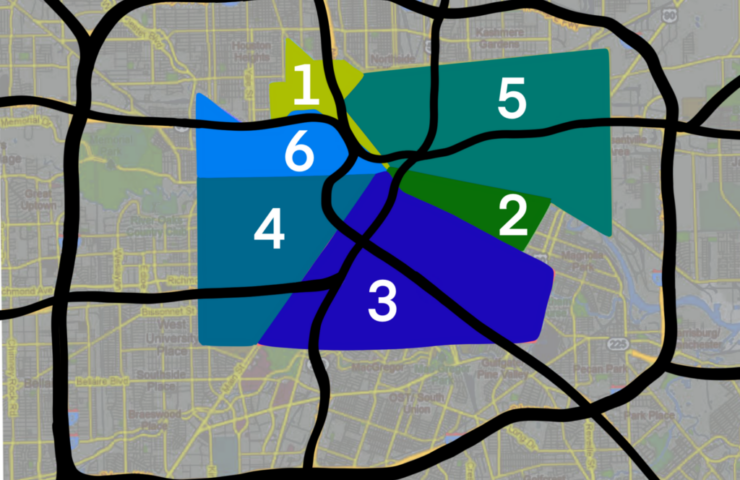Graphic by: Alina Velasquez
Whether you are a native Houstonian or a newcomer, it’s likely that you’ve heard people refer to different places in Houston as the wards. What started off as political divisions in the city, now holds personal and cultural meaning.
Even though wards have not been officially used for more than 100 years, they are still a part of Houstonians’ vocabulary and how they view the city. In the early nineteenth century, the wards system was used for a decentralized government with numerous officials elected frequently.
This Jacksonian tendency was used in Boston, New Orleans, Houston, New York and Chicago, which still uses the wards system.
The first four wards were formed at the intersection of Main Street and Congress Avenue, the innermost boundaries that extend out to the city limits. The northland of Congress and west of Main became the First Ward. The other three followed suit clockwise. The fifth ward was added in 1866 and it consisted of north Buffalo Bayou and east of White Oak Bayou.
It was not until 1877 that the Sixth Ward was added after being carved out of the Fourth Ward’s North. The Sixth Ward did not get formal representation in City Council until 1896.
Discussing the history of the system, how it was established and used in the city can go on for days. Here is a brief breakdown of the six wards.
First Ward
Established with the city of Houston, the First Ward holds a history, mostly consisting of farms at the time of its founding. The ward is also noted for its springs. In the mid-nineteenth century, it provided its residents with a cleaner source of water than Buffalo Bayou, which most Houstonians depended on.
The ward was demographically “highly integrated” by 1870. In the latter half of the nineteenth century, gambling houses had gained popularity in the First Ward. The district known as Vinegar Hill, held the more notorious activities, particularly in a one-block region nicknamed Tin Can Alley.
The ward remained the smallest of the original four wards and had been divided into two parts by the early twenty-first century: the Low First Ward — east of Houston Avenue and the High First Ward — west of Houston Avenue.
Second Ward
Second Ward acted as a focal point during the city’s twenty-first-century industrial expansion. The neighborhood is one the most historic and culturally significant neighborhoods that maintained a strong identity for much of the 20th century.
This neighborhood plays host to many different ethnic groups and people from various cultures. During the mid to 19th century, Germans settled in. Italians and Anglos and then Hispanic communities beginning in the 1920s followed, gaining in numbers by the 1940s.
It is home to Houston’s iconic City of Houston Landmark, two State of Texas Recorded Historic Landmarks and numerous landmark sites and districts that date from the 1870s, the 1930s and 1940s.
Third Ward
Home to the University of Houston, the Third Ward is a historically Black neighborhood that holds significant meaning to its residents. The ward has been called the “cradle of the city’s civil rights movement.”
In 1960 Black college students first sat down at a segregated Third Ward lunch counter to first protest discriminatory policies. A great deal of social activism from the African American community came from the Third Ward.
The neighborhood gave birth to the esteemed Black Ensemble Theatre, the Houston Museum of Art and Culture and Project Row Houses. It is also home to the musical icon, Beyoncé.
Fourth Ward
Home to “Freedman’s Town,” the Fourth Ward is where the first freed slaves settled on Buffalo Bayou’s southern edge, constructing small shanties as houses. The 1,000 slaves chose this area as it was prone to flooding and swampy.
The settlers paved the stress with handmade bricks themselves, according to oral history. In the early 20th century members of the congregation of the Rev. Jeremiah Smith paved Andrew Street with the first bricks after the City of Houston refused to pave it.
The ward lost its promise due to its inability to grow geographically. In the 1920s, the Third Ward surpassed the Fourth Ward as the center of Houston’s African American community.
Fifth Ward
The Fifth Ward was inhabited before the Civil War. Freedmen later occupied the area when an alderman was elected to represent the community in the Houston city government.
The population in the area was partially African American and partially Anglo. By 1970, the population in the ward compromised 578 Black residents and 561 white residents. The Fifth Ward eventually became a predominantly Black neighborhood in modern timing.
Sixth Ward
Industrial activity was on the rise in Houston when the Sixth Ward was carved out from the north part of the Fourth Ward.
In 1978, the Department of Interior designated the ‘The Old Sixth Ward’ located between Memorial Drive and Washington Avenue, a historical district, making it the first National Register District in Harris County.





Recent Comments